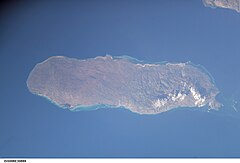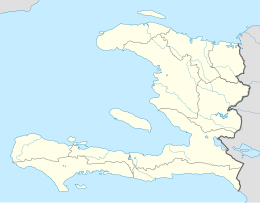Gonâve Island
Native name: Guanabo | |
|---|---|
 View of Gonâve Island from space | |
| Geography | |
| Location | Gulf of Gonâve |
| Coordinates | 18°50′N 73°05′W / 18.833°N 73.083°W |
| Area | 689.62 km2 (266.26 sq mi) |
| Highest elevation | 778 m (2552 ft) |
| Highest point | Morne La Pierre |
| Administration | |
Haiti | |
| Department | Ouest |
| Largest settlement | Anse-à-Galets (pop. 49,050) |
| Demographics | |
| Demonym | Gonâvians |
| Population | 87,077 (2015) |
| Pop. density | 126/km2 (326/sq mi) |
| Pointe Fantasque Lighthouse | |
| Foundation | concrete base |
| Construction | metal skeletal tower |
| Height | 15 m (49 ft) |
| Shape | square pyramidal tower with balcony and light[1][2] |
| Markings | white tower |
| Power source | solar power |
| Focal height | 20 m (66 ft) |
| Range | 9 nmi (17 km; 10 mi) |
| Characteristic | Q(6)+LFI W 15s |
Gonâve Island or Zil Lagonav (French: Île de la Gonâve, pronounced [ɡɔ.nɑv]; also La Gonâve) is an island of Haiti located west-northwest of Port-au-Prince in the Gulf of Gonâve. It is the largest of the Hispaniolan satellite islands. The island is an arrondissement (Arrondissement de La Gonâve) or Ouest-Insulaire in the Ouest and includes the communes of Anse-à-Galets and Pointe-à-Raquette.[3]
Etymology
[edit]La Gonâve or Gonave is a francized form of Guanabo, the Taíno and later Spanish name for the island and region.
History
[edit]Taíno period
[edit]The indigenous Taínos called the island Guanabo. Under the leadership of Hatuey, the island was the last refuge of the natives after the invasion of the Europeans.
European period
[edit]No major French or Spanish settlement was built in La Gonâve. During the colonial period, the island was uninhabited by colonists, which led the indigenous Taínos to seek refuge there after early battles with the Spanish.[4] Runaway slaves in the French period, too, sometimes sought out the island for a place to hide from their owners on the mainland.[5]
Haitian period
[edit]The island has been officially under Haitian control since Toussaint Louverture and the Constitution of 1801.
Modern period
[edit]On July 18, 1926, U.S. Marine Corps Sergeant Faustin E. Wirkus (1896–1945) was proclaimed by the residents of the island as King Faustin II, where he ruled over the island with the tribal queen Ti Mememnne as co-monarchs. His reign lasted until 1929, when he peacefully abdicated and returned home to the United States.[6] Ti Memenne continued to unofficially rule the island until her death in that same year. For context, Haiti is a republic and abolished the monarchy in 1859 with Fabre Nicolas Geffrard.
In the mid-1980s, British singer Cliff Richard wrote and recorded a song "La Gonave" for relief aid for the people of the island. It is included on his album The Rock Connection.
The island's docks were damaged by the 2010 Haiti earthquake on 12 January. In the wake of the damage, supplies were airlifted in to the 550-metre (1,800 ft) dirt strip.[7]
Overgrazing and over-exploitation of water resources affect the island's current residents.[citation needed]
Independence movement
[edit]The island inhabitants have pushed the idea of independence from Haiti in order to achieve economic prosperity.[8]

Geography
[edit]The island sits in the middle of the Gulf of Gonave, south of St-Marc, north of Miragoanes, and west of Port-au-Prince. It forms the canal of St-Marc with the Cote des Arcadins and the Canal of the South and Miragoanes.
Made up of mostly limestone, the reef-fringed island of Gonâve is 60 km (37 mi) long and 15 km (9 mi) wide and covers an area of 743 km2 (287 sq mi). The island is mostly barren and hilly with the highest point reaching 778 m (2,552 ft). The island receives between 800 mm (31 in) to 1,600 mm (63 in) of rain a year, higher elevations representing the latter figure.[9]
The barren, dry nature of the soil has long prevented agricultural development on the island and kept the population lower than it otherwise might have been.
Administrative division
[edit]La Gonâve arrondissement is divided into two communes: Anse-à-Galets and Pointe-à-Raquette. These are further subdivided into eleven sections and two towns (villes). The towns are Anse-à-Galets and Pointe-à-Raquette, named after their respective communes. Anse-à-Galets is the largest settlement on the island with an estimated 2015 population of 52,662 of the island's total population of 87,077.[10][11]
| Anse-à-Galets | Pointe-à-Raquette |
|---|---|
| 1st Palma | 5th Gros Mangle |
| 2nd Petite Source | 6th La Source |
| 3rd Grande Source | 7th Grand Vide |
| 4th Grand Lagon | 8th Trou Louis |
| 10th Picmy (Pickmy) | 9th Pointe-à-Raquette |
| 11th Petite Anse |
Water scarcity
[edit]In 2005, following a particularly drastic drought, the Mayor of Anse-à-Galets formed the Water Platform, composed of service groups working on the island. Current participants include the Mayors of Anse-à-Galets and Pointes a Racquette, the Deputy, Justice of the Peace, World Vision, Concern WorldWide, Sevis Kretyen, the Matènwa Community Learning Center, the Alleghany Weslyen Church, the Methodist Church, Haiti Outreach and many others. The Water Platform acts as a focal point for activities on the island, providing a coordination point for the multitude of groups working on La Gonâve.
Assistance efforts
[edit]The members of the Water Platform have been working to address the water needs of the island by capping springs, building rainwater catchment cisterns, building water systems and drilling wells. Dozens of rainwater catchment cisterns and wells have been drilled on the island as an effort to bring water relief to the residents of the island.
2002–2004 Guts Church funded construction of a school providing first through sixth grade education and construction of a medical clinic providing free medical, dental and vision services for Haitians.
As of 2007[update], there were two non-profit groups actively drilling water wells on the island: Haiti Outreach, which has financed and drilled water wells in 25 communities; and Guts Church in Tulsa, Oklahoma. The Tougher Than Hell Motorcycle Rally, organized by Guts Church, has sponsored 10 water wells drilled on the island.
In 2010 Coordinated relief efforts after the 12 January earthquake. $250,000 was raised for this relief project. Medical supplies, building supplies, 150 tons of rice and beans and a backhoe were purchased. Aid was shipped to La Gonâve via a leased vessel and delivered directly to La Gonâve in early March 2010. The aid shipment fed 50,000 people for one month.
As of 2011[update] there are over 70 water wells fully functional on the island. The drilling of more wells on the island has been planned for the near future.[12]
Since 2007, the Washington D.C.–based nonprofit Roots of Development and its La Gonâve–based Haitian sister organization Rasin Devlopman have been providing leadership and capacity-building programs to community leaders and locally elected officials on the island. The two organizations provide leaders access to professional facilitators, workshops and trainings, and material and financial resources, to help them strengthen local capacity and improve quality of life on the island.
Founded in 2014, the Australian-based non-profit organisation For You Haiti began coordinating surgeries for children from la Gonâve island. The children receive medical treatment on the mainland of Haiti and in the United States. For You Haiti has a mentoring program for men and women to start small businesses in Haiti, with the goal of empowering communities to break the cycle of poverty. In 2016, For You Haiti started the Hungry Tummies Project at Complexe Scolaire Amis des Enfants and began growing their own food in the region of Palma, in the hope of making lasting change for the la Gonâvian people.
Ferry disaster
[edit]On 8 September 1997, the passenger ferry La Fierte Gonavienne (The Pride of Gonave) operating from La Gonâve to the Montrouis on the Haitian mainland sank with hundreds of passengers aboard.[13] It is considered the worst disaster in Haitian maritime history since the Neptune accident in 1993.[14]
Media
[edit]- Radio Zetwa 89.1 FM
Sports team
[edit]- Roulado FC – professional football club
Notable natives and residents
[edit]- Faustin E. Wirkus – King of La Gonâve (Faustin II)
- Ti Memenne of La Gonâve – Queen of La Gonâve
See also
[edit]References
[edit]- ^ Rowlett, Russ. "Lighthouses of Haiti". The Lighthouse Directory. University of North Carolina at Chapel Hill. Retrieved 22 January 2017.
- ^ List of Lights, Pub. 110: Greenland, The East Coasts of North and South America (Excluding Continental U.S.A. Except the East Coast of Florida) and the West Indies (PDF). List of Lights. United States National Geospatial-Intelligence Agency. 2016.
- ^ Description de Saint-Domingue, M.L.E. Moreau de Saint-Méry, vol. 2, p. 528, Philadelphia: 1798.
- ^ Description de Saint-Domingue, p. 528.
- ^ "Les Affiches Américaines", 19 March 1766, pg. 102 (accessed 30 May 2014)
- ^ Wallace, Amy; Jane Farrow; IRA Basen (November 2005). "9 Ordinary men who became king (#9)". The Book of Lists, the Canadian Edition: The Original Compendium of Curious Information. Knopf Canada. p. 273. ISBN 0-676-97720-0.
- ^ The Bahamas Weekly, "Bahamas Habitat completes 150th Haiti relief flight", GeneralAviationNews.com, 4 February 2010 (accessed 4 February 2010)
- ^ https://www.icihaiti.com/en/news-28680-icihaiti-gonave-a-wind-of-independence-blows-on-the-island.html [bare URL]
- ^ "National Aeronautics and Space Administration". Archived from the original on 10 October 2006. Retrieved 7 September 2006.
- ^ "Sections communales et villes de la République d'Haiti". Gexpert Haiti. Retrieved 29 May 2014.
- ^ IHSI, "POPULATION TOTALE, POPULATION DE 18 ANS ET PLUS MENAGES ET DENSITES ESTIMES EN 2009" Archived 24 November 2014 at the Wayback Machine, March 2009 (accessed 30 May 2014)
- ^ "About | You Help Haiti". Archived from the original on 7 December 2013. Retrieved 29 April 2013.
- ^ "Red Cross lowers estimate of Haitian ferry victims". CNN. 9 September 1997. Retrieved 21 July 2024.
- ^ Rohter, Larry (9 September 1997). "More Than 300 Feared Lost on Haiti Ferry". New York Times. Retrieved 1 April 2016.


